Trinidad and Tobago's property market continues to recover
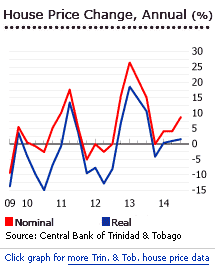 Trinidad and Tobago’s property prices started to rise again in 2014, after lacklustre performance over the past several years, according to the Association of Real Estate Agents (AREA). Property prices fell 20% from 2007 to 2009 due to the adverse impact of the global crisis. During the year to the third quarter of 2014, residential property prices rose by 8.7% y-o-y to an average of TT$1.25 million (US$200,000), based on the figures released by the Central Bank of Trinidad and Tobago.
Trinidad and Tobago’s property prices started to rise again in 2014, after lacklustre performance over the past several years, according to the Association of Real Estate Agents (AREA). Property prices fell 20% from 2007 to 2009 due to the adverse impact of the global crisis. During the year to the third quarter of 2014, residential property prices rose by 8.7% y-o-y to an average of TT$1.25 million (US$200,000), based on the figures released by the Central Bank of Trinidad and Tobago.
House prices in the islands range from around TT$1.5 million (US$240,000) to TT$8 million (US$1.26 million), depending on size, location and amenities - though of course there are super-luxurious and also low-end houses that fall well outside this range.
At The Crossings, located on the outskirts of the bustling town of Arima in Trinidad, three bedroom houses are currently being offered for around TT$1.78 million (US$280,000). On the other hand, residential land in The Crossings sells for less than TT$120.5 (US$19) per square foot (sq. ft.).
The housing market is expected to continuously improve this year, despite weak economic growth. The economy is projected to grow by 1.2%, after real GDP growth rates of 1.1% in 2014, 1.7% in 2013, 1.4% in 2012, and 0.01% in 2011, according to the International Monetary Fund (IMF).
Housing boom and bust
Trinidad and Tobago saw a massive housing boom from 1991 to 2006, with house prices surging by more than 400%, amidst strong construction activity, high oil prices and flourishing petrochemicals sector. Foreign investment poured in. Much new private housing was built in Port of Spain, in the northwest region, and the area around Point Lisas Industrial Estate, the centre of Trinidad and Tobago’s petrochemical industry.
As the global economic recession set in, demand fell sharply. Construction activity slowed, as projects were completed or halted. Foreign investment fell, and unemployment rose – reaching almost 6% in 2010. Financial and investor confidence also tumbled when CL Financial, Trinidad and Tobago’s largest privately-held conglomerate (and one of the largest in the Caribbean), collapsed due to high leverage and risky investments, and had to be rescued by the government.
Then the government introduced a new property tax – a 3% tax rate on residential property and a 5% tax rate on commercial property, based on 90% of annual rentable value. This aroused a lot of anger. After the victory of new PM Kamla Persad-Bissessar, elected in May 2010, the reform was suspended by the new People’s Partnership-led coalition government. The previous Lands and Buildings Taxes Act rates and values were reintroduced.
Property prices plunged by about 20% from 2007 to 2009 due to the global crisis. Not until 2014 did the market substantially improve. Demand is now slowly coming back. Construction activity is increasing. House prices are now rising again.
Interest rates and the mortgage market
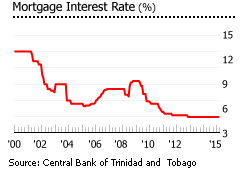
From a high of 17.5% in January 2000, the average mortgage interest rate dropped to 9.13% in February 2005, fuelling the country’s massive housing boom. However, benchmark interest rates were then raised, which caused the mortgage rates to follow, reaching 13% in October 2008.
To boost the economy and the property market, interest rates were reduced several times after 2009, and both the basic prime rate and the average mortgage rate fell to 7.5% in November 2012, according to the Central Bank of Trinidad and Tobago. In February 2015, the average mortgage interest rate remained unchanged at 7.5%.
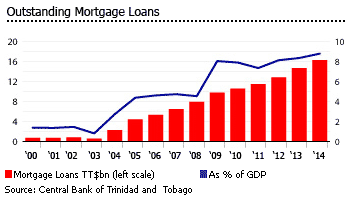
Trinidad and Tobago’s mortgage market has expanded rapidly in the past decade. From just roughly about 0.8% of GDP in 2003, the size of the mortgage market expanded to about 8.8% of GDP in 2014.
In February 2015, the total amount of mortgage loans outstanding rose by 10.4% from the same period last year, to TT$16.53 billion (US$2.61 billion), according to the Central Bank of Trinidad and Tobago.
The expat rental market
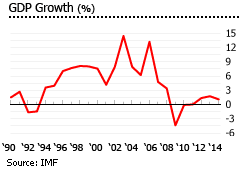
Trinidad and Tobago’s upscale neighbourhoods, mostly in the West region, became popular with expats during the housing boom, and commanded high rentals. However, the economic downturn caused an outflow of these foreign renters. As a result, rents for a large number of properties fell substantially.
For the expatriate and upper-income markets, there is a wide range of residential rents - from TT$9,514 (US$1,500) to TT$95,142 (US$15,000) per month at end-2014.
For the local market, more particularly the middle income market, residential rents for apartments and properties in gated communities typically range from TT$3,000 (US$473) to TT$20,000 (US$3,153).
Some of the most attractive locations to rent or buy in Trinidad are:
Westmoorings – upscale Port of Spain suburb, with high-rise apartment complexes
Goodwood Park – exclusive neighbourhood near Port of Spain, with large private houses
Bayside Towers – new luxurious apartment complex
The Greens, Maraval Valley – modern, luxurious gated community
Slow economic growth
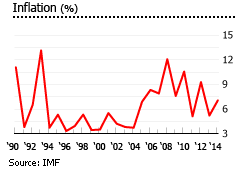
Trinidad and Tobago is one of the Caribbean´s richer nations. The island of Trinidad is world-famous for the Trinidad Carnival, but unlike many of its Caribbean neighbours which rely on tourism, Trinidad depends heavily on oil and gas production. The energy sector accounts for more than 40% of GDP and 85% of merchandise exports. Its sister island Tobago, which has a wealth of secluded beaches and rainforests, benefits from the larger island’s prosperity.
However wealth does not bring immunity from recession. In 2009 Trinidad and Tobago’s GDP contracted by 4.4%, followed by a 0.1% contraction in 2010. There was recovery in 2012 with 1.4% GDP growth, 1.7% growth in 2013, and 1.1% growth in 2014. The economy is projected to grow by 1.2% this year, according to the International Monetary Fund (IMF).
In March 2015, the country’s overall inflation rate stood at 6.6%, according to the Central Statistics Office. Inflation stood at 7% last year, from 5.2% in 2014, 9.3% in 2013, 5.1% in 2012 and 10.5% in 2011, according to the IMF. Inflation is expected to be 7.3% this year.
After a period of decline during the global economic crisis, the construction industry is getting a boost from the government’s development plan “Vision 2020”, which consists mainly of construction projects.
In the past several years, the government has prioritized economic diversification, focusing its efforts not just in the energy sector, but also in the non-energy sector and services sector.
Challenge for new government - fighting corruption, reducing crime
Mrs Kamla Persad-Bissessar, a former lawyer and education minister, became the country’s first woman Prime Minister in 2010. She called her new government the “People’s Partnership”, emphasizing openness and political accountability – in contrast to the previous government of Patrick Manning, who was accused of using government funds to finance his lavish lifestyle.
While many local residents in Trinidad and Tobago are prosperous, 17% of the population live below the poverty line. Crime involving drugs, guns, and gangs remains a challenge particularly in Trinidad, with murders and kidnappings topping the list.
The next elections were scheduled for September 7, 2015, political analysts expect a tight race between the ruling People’s Partnership and the People’s National Movement.
Buying property
In Trinidad, foreign real estate buyers can buy up to one acre of property for residential use without a license. In Tobago, by contrast, no license have been issued to foreign buyers since a requirement for licenses was introduced in October 2007.
Buyers are required to pay 5% to 10% stamp duty, plus legal fees.